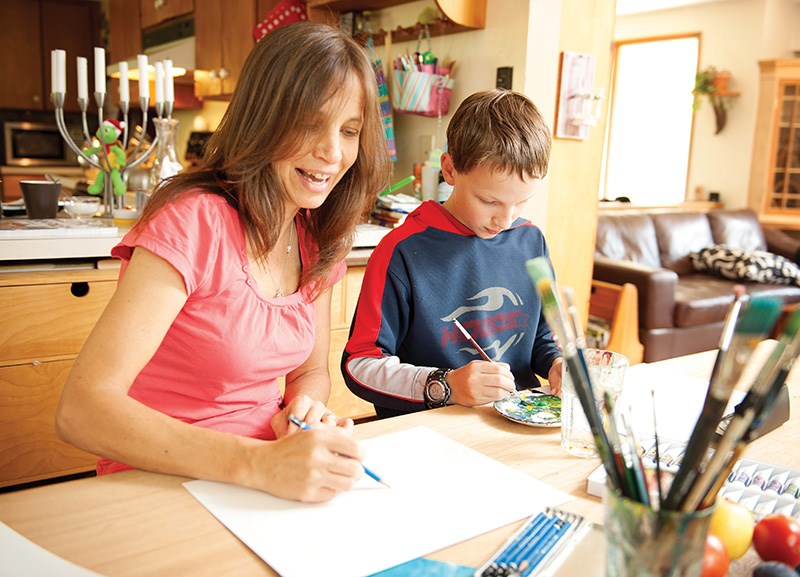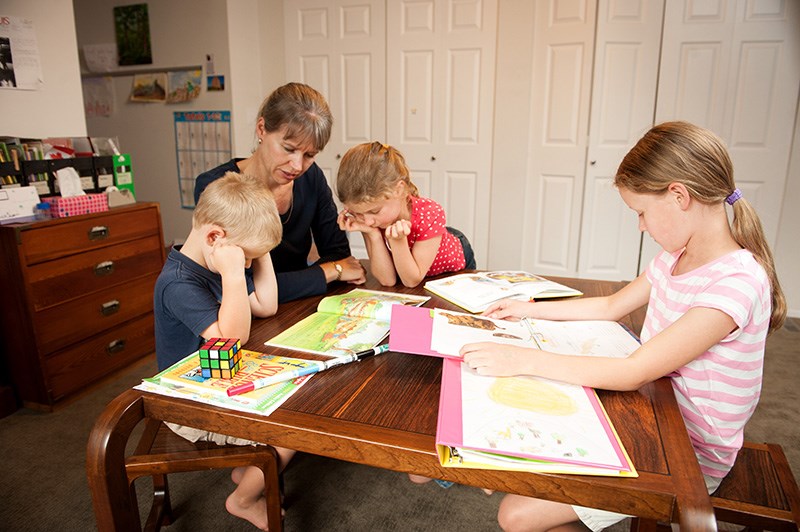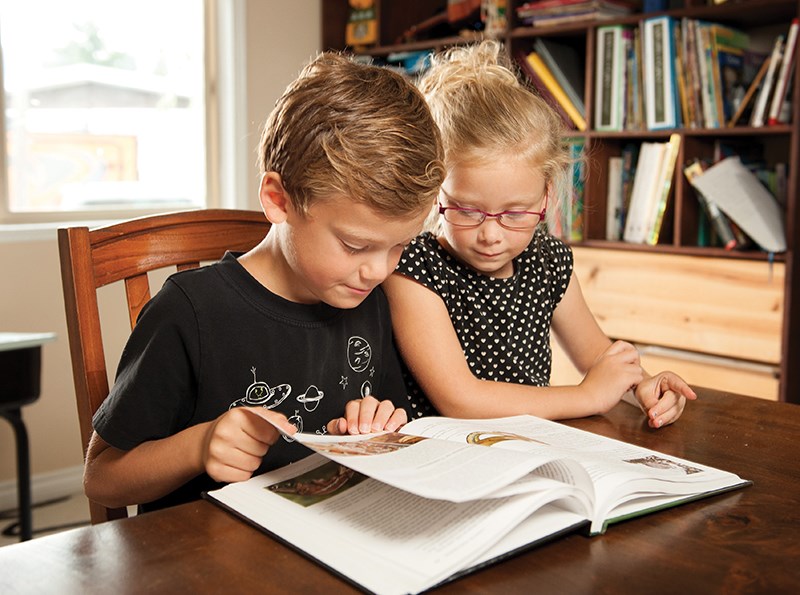Homeschooling is gaining ground in Squamish as a way to educate children.
“Parents choose homeschooling for a variety of reasons,” says Marilyn Caldwell, Sea to Sky School District director of learning services. “It’s usually focused on the needs of their family, their beliefs and how they want their children to be educated, so we work in partnership with them in helping them get there.”
The reasons may include extensive travel, anxiety at school, long-term illness or, for high-level athletes, the need to train while learning, Caldwell says.
It’s also a choice the family can reevaluate over time, and a transition plan created between parents and school can help ease a child back into a regular classroom if needed.
According to the Ministry of Education, there are two methods of home learning, distributed learning and regular homeschooling.
With distributed learning (DL), the child is enrolled in a public or independent school DL program directed and supervised by a С����Ƶ-certified teacher. The majority of learning takes place at home, often online, but students receive on-going regular assessments, report cards, provincial letter grades and a permanent student record, and parents receive teacher support.
With regular homeschooling, the parent delivers the education, enabling students to direct their own learning and work at their own pace. Children must still be registered at a school in the province by Sept. 30 each year, but the teaching falls entirely to the parents without supervision by a certified teacher or inspection by the Ministry of Education.
Susanna and Colin Lye chose DL three years ago for their eldest children Josiah, 8, and Emily, 6. Josiah went to kindergarten for a year and had an exceptional teacher, says Susanna, but as a mother, she wanted to do more.
“I felt like I wasn’t fulfilling my role as a mom in teaching my kids because they were already being taught…. I felt like a piece was missing on my part.”
Pulling him out wasn’t easy, explains Colin, who as a child was homeschooled for a year and hated it.

“I was very social… and the homeschooling network was very tiny, so if I wasn’t in school, I didn’t meet with friends. But my brothers were bullied quite a lot in school and loved being away from that atmosphere.”
For their own children, they enrolled with the Heritage Christian Online School and follow a strict daily schedule, but there’s definitely flexibility, Colin explains, such as learning on statutory holidays in exchange for days off that better fit the family’s schedule.
There’s also accountability and resources (students receive limited funding), in addition to a support teacher who visits at least three times a year, explains Susanna.
Even with support, her role as home educator is demanding and requires organization, but it’s also rewarding, she says. “I love it… to be here in the midst of my children is such a blessing.”
Living on one income was definitely a consideration, she explains, “but we try and stay humble and keep a small home.”
Among their support network is the Squamish Home Learners Support Group – something in which Trudie Neubert, a trained kindergarten teacher, is also involved.
Neubert homeschooled her children, Calvin, 18, Sonia, 15, and Daniel, 12. She made the decision after discovering Calvin wasn’t happy at kindergarten. At a friend’s suggestion, she looked into home education – something that was not permitted in her home country, Germany – and chose homeschooling over DL.
For Calvin, she says, it has made a big difference. It’s flexible too, as when he entered Grade 10, he registered with a DL program and worked towards his Dogwood. He’s about to graduate from Grade 12.
Sonia has just written her Grade 10 math exam, and Daniel is also registering for online studies.
Being able to blend homeschooling with DL has also provided the family with teacher support in the curriculum’s more advanced areas.
In the beginning, though, they set their own learning. “I always incorporated the children in lesson plans,” says Neubert, explaining their suggestions included anything from studying the Civil War to mosquitoes.
“We would go to the library, take out books and read for hours, or do crafts, model building and projects,” she says.
With other children and parents in the support group, they would also visit places like Alice Lake, the symphony orchestra pit and the police station.
As the group grew, mothers took turns teaching specialties to the children such as art, German or drama.
“It was really awesome for the kids, having other kids around while they were learning. It’s always a bit challenging… but we made it work.”
Being with your children 24/7 can also be challenging, she says.
“I started working at the library, just six hours a week. It was really nice for me just to have something for myself.”
Even volunteering, she explains, can give you a break.
Nicolene Wildervanck, mother of Erika, 11, Bianca, 9, Emma, 6, and Frits, 4, began homeschooling in South Africa before moving to Squamish 18 months ago.
A trained elementary teacher and once a staunch supporter of schools, she became inspired by The Successful Homeschool Family Handbook and, like Neubert, chose homeschooling over DL saying, “It’s all on me... but we can do whatever we want, how we want.”
Recently that involved a trip to Science World, and soon, a visit to the Vancouver Art Gallery to view its Italian art exhibition. “We’ll see all the paintings, talk about the painters and maybe look up Italy on the map.”
Allowing the children to direct their own learning provides flexibility, she explains, and when they’re eager to listen, they learn more.
Topics can range from Bach to baking, and although her children range in age, they often learn together.
“My oldest daughter is doing a project on ancient Egypt. She decided she wanted to know more… so we went to the library and got the books out.”
While Erika makes notes, Wildervanck reads to the others and discusses pyramids and mummies.
“We’re also doing an experiment where we mummified apples,” she says, explaining everyone wanted to be involved. “Although they weren’t officially learning about ancient Egypt, they were learning all kinds of things through their sister doing it.”
Although people suggest there are things they won’t learn, she says, “you cannot know everything. It’s impossible. I just feel, the disposable time that you have for learning, use it for something that really interests you.”
People also ask how homeschooled children learn to read, but it doesn’t worry her. “Reading is like learning to walk; it happens naturally.”
For this reason, her children aren’t forced to learn things for which they’re not ready – whether it’s reading, writing or math – because she knows it will come with time. And that she says, relieves pressure for everyone.
There are also no set times for learning, she says, “It happens the whole time.” Whether discussing math while baking or nature while hiking, she says, “We view the world as our classroom…everything is incorporated into our learning.”
Running a household while homeschooling can be exhausting, and there are sacrifices, she says, “but I guess everything that’s worthwhile is hard work. When I see the children and how they enjoy it, and the relationship we have with each other, I wouldn’t change it for the world.”
For more information about homeschooling, visit www.bced.gov.bc.ca.





